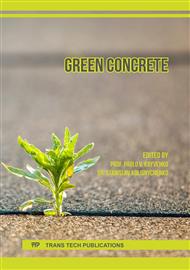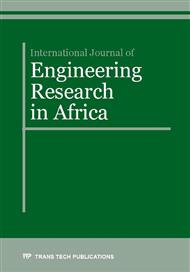[1]
P. O. Awoyera, J. K. Ijalana, O. E. Babalola, Influence of Steel and Bamboo Fibres on Mechanical Properties of High Strength Concrete, J. Mater. Environ. Sci. 6 (2015), 3634-3642.
Google Scholar
[2]
I. I. Akinwumi, O. M. Olatunbosun, O. M. Olofinnade, P. O. Awoyera, Structural Evaluation of Lightweight Concrete Produced Using Waste Newspaper and Office Paper, Civ. Environ. Res. 6(7), 2014, 160 – 167.
Google Scholar
[3]
P. O. Awoyera, A. W. Adekeye, O. E. Babalola, Influence of Electric Arc Furnace (EAF) Slag Aggregate Sizes on the Workability and Durability of Concrete, Int. J. Eng. Tech. 7(3), 2015, 1049 – 1056.
Google Scholar
[4]
S. Rafat, Utilization of wood ash in concrete manufacturing. Resources, Conservation and Recycling, 67 (2012), 27– 33.
DOI: 10.1016/j.resconrec.2012.07.004
Google Scholar
[5]
T. Ramos, A. M. Matos, J. Sousa-Coutinho, Mortar with wood waste ash: Mechanical strength carbonation resistance and ASR expansion. Constr. Build. Mat. 49 (2013), 343–351.
DOI: 10.1016/j.conbuildmat.2013.08.026
Google Scholar
[6]
C. C. Ban, M. Ramli, The implementation of wood waste ash as a partial cement replacement material in the production of structural grade concrete and mortar: An overview. Resources, Conservation and Recycling, 55 (2011), 669–685.
DOI: 10.1016/j.resconrec.2011.02.002
Google Scholar
[7]
S. Chowdhury, A. Maniar, O. M. Suganya, The incorporation of wood waste ash as a partial cement replacement material for making structural grade concrete: An overview. Ain Shams Eng. J., (In Press).
DOI: 10.1016/j.asej.2014.11.005
Google Scholar
[8]
T. R. Naik, R. N. Kraus, R. Siddique, Demonstration of manufacturing technology for concrete and CLSM utilizing wood ash from Wisconsin, Wisconsin Department of Natural Resources (Madison, WI) for project #1-06 UWM report no. CBU-2002-30.
Google Scholar
[9]
M. Bederina, M. Gotteicha, B. Belhadj, R. M. Dheily, M. M. Khenfer, M. Queneudec, Drying shrinkage studies of wood sand concrete – Effect of different wood treatments. Constr. Build. Mat., 36 (2012), 1066–1075.
DOI: 10.1016/j.conbuildmat.2012.06.010
Google Scholar
[10]
B. Belhadj, M. Bederina, N. Montrelay, J. Houessou, M. Quéneudec, Effect of substitution of wood shavings by barley straws on the physico-mechanical properties of lightweight sand concrete. Constr. Build. Mat. 66 (2014), 247–258.
DOI: 10.1016/j.conbuildmat.2014.05.090
Google Scholar
[11]
S. Chowdhury, A. Maniar, O. M. Suganya, Strength development in concrete with wood ash blended cement and use of soft computing models to predict strength parameters. J. Adv. Res. (In Press).
DOI: 10.1016/j.jare.2014.08.006
Google Scholar
[12]
D. Eliche-Quesada, F. A. Corpas-Iglesias, L. Perez Villarejo, F. J. Iglesias-Godino, Recycling of sawdust, spent earth oil from filtration, compost and marble residues for brick manufacturing. Constr. Build. Mat. 34(2012), 275–84.
DOI: 10.1016/j.conbuildmat.2012.02.079
Google Scholar
[13]
R. W. J. Keay, Trees of Nigeria Revised. Oxford University Press, New York, (1989).
Google Scholar
[14]
J. A. Thia, The Plight of Trees in Disturbed Forest: Conservation of Montane Trees, Nigeria. Master Thesis, School of Biological Sciences, University of Canterbury, (2014).
Google Scholar
[15]
American Standard for testing and Materials (ASTM) Standard specification for coal fly and calcinated natural pozzolanas for use in concrete, ASTM 618-94, (1994).
Google Scholar
[16]
E. Bolza, Wood Technology, Onward London, www. fiwge. com.
Google Scholar
[17]
British Standard Institution, Method for determination of compressive strength of concrete cubes, BS 1881, part 116, London, (1975).
Google Scholar
[18]
A. M. Neville, Properties of concrete, Longman Group, UK limited, third edition, 19981, pp.161-162.
Google Scholar
[19]
British Standard Institution, determination of slump, BS 1881, part 102, London, (1983).
Google Scholar
[20]
British Standard Institution, Method of testing of soil for civil engineering purpose, BS 1377, London, (1990).
Google Scholar



